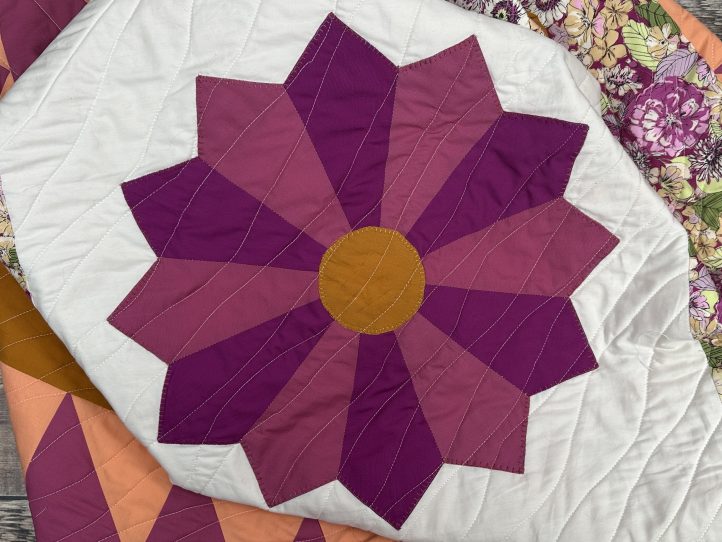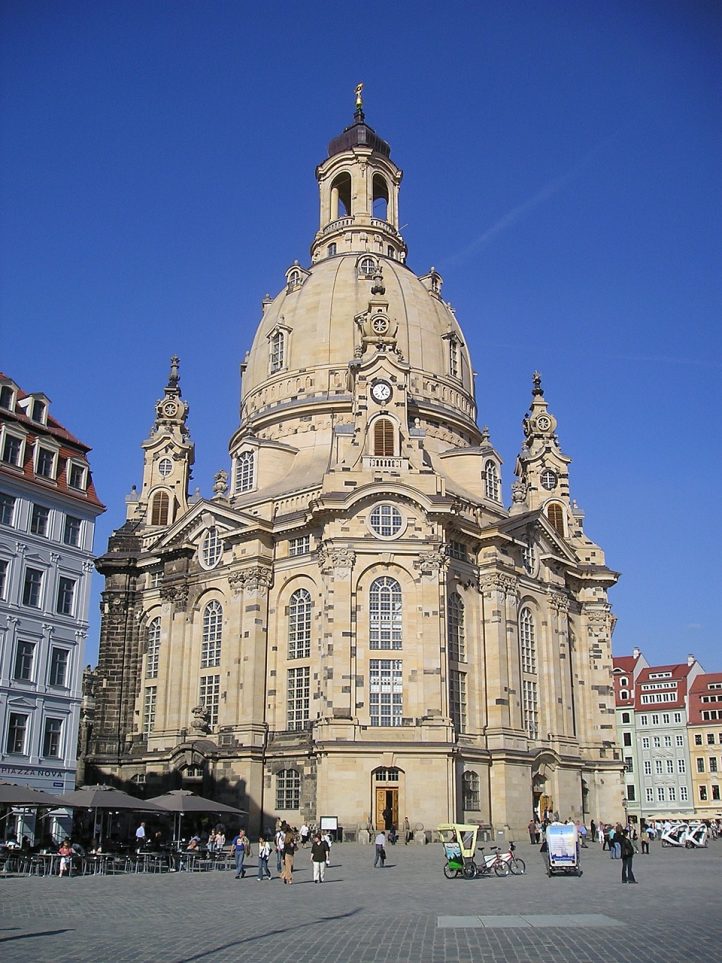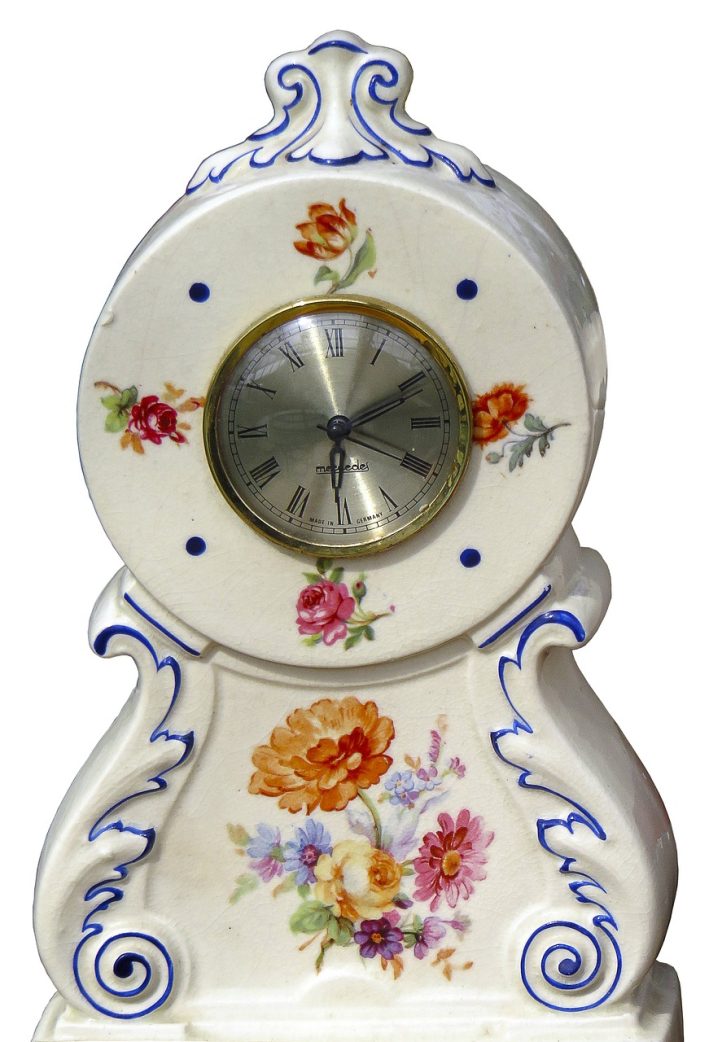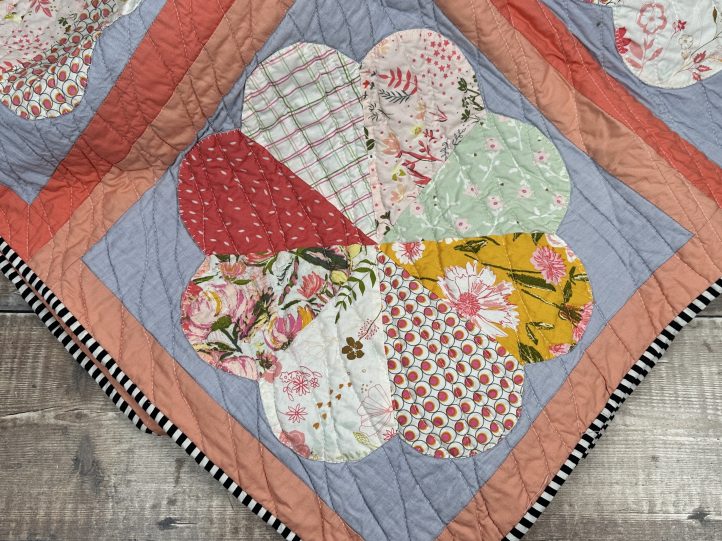
Photo provided by designer.
The history of the Dresden Plate quilt block has some twists and turns and some dispute over its real origin. We know some very real facts about the block- it enjoyed the peak of its popularity between the 1920s and the 1950s and in company with many other crafts and styles, it was known as a Depression block despite its birth before the Great Depression and its continuing popularity after. All that and it has something to do with Dresden, the capital of the German state of Saxony.
Then we go into murkier waters and the facts become a little harder to grab hold of. A great controversy is the question of what exactly inspired the Dresden Plate quilt block. Due to extensive and controversial allied firebombing of Dresden during World War II, it is reckoned that many (if not most) examples of Dresden plates were destroyed and this has made it very difficult to clear up the first point: Was the block named after a china plate itself or the marking on the bottom? It is quite strange to me that this presents itself as such a problem- surely enough examples of the work would have sold and migrated to different parts of the country so that they could be examined now to put this one to bed once and for all. There are certainly many Dresden pieces in museums and art galleries. And yet the mystery seems to continue.
All About Dresden

Photo provided by designer.
The city of Dresden is situated in the east of Germany and is widely regarded as one of Germany’s gems, a beautiful and treasured city despite the war damage. Its Baroque architecture, cultural richness and the stunning natural landscape of the Elbe River has given rise to its alter ego of ‘The Florence of the Elbe’. And it is fair to say that a lot of reconstruction work, to excellent effect, has taken place since the war.
When we talk about Dresden today, very often the images which may come to mind are of the famous Dresden porcelain. That is, Dresden and the nearby city of Meissen who had already claimed their fame as the first European manufacturers of hard paste porcelain around 1708. Meissen was where the porcelain pieces were cast and fired before being transported to Dresden to be decorated by the highly skilled painters there.

Photo provided by designer.

Photo provided by designer.
China was the first to manufacture porcelain a thousand years before Europe entered the game and they kept their secrets close. But of course, as is often the way of these things, the secrets seeped out and arrived in Europe where porcelain making fascinated just about everyone lucky enough to see a piece up close. It was known as white gold and some of the prices that it fetched in the 18th century were pretty fascinating, too. The time was right to get some sort of industry going closer to home.

Photo provided by designer.
The ingredients needed (once they were known) ideally had to be found locally and as luck would have it, the all-important kaolin was to be found around Dresden in Saxony, Germany. So Dresden in concert with nearby Meissen created some unforgettable pieces of porcelain, which came to be associated with great wealth, taste and refinement and of all the patterns and molds and the decorations used, the Dresden plate itself was to reach out to inspire other crafters.
And by the way, the romantic city of Dresden gave us milk chocolate and (strangely appropriately) toothpaste so even if you have no desire to visit for the sake of a plate, there are other inducements on offer!
The History of the Dresden Plate
But what has this to do with our beloved Dresden Plate design? Well, there is a consensus that the Dresden Plate quilt pattern was at least inspired by that city’s famous porcelain flatware. That is until a voice from the back pipes up and points out that there was a Dresden Fan design made popular by quilters in the 1890s. We will get to that shortly.
The Dresden Plate was a handy design to have in the patchwork repertoire- it was made of multiple blades to form a circle before being appliquéd to a background. I say ‘multiple’ because some sources demand that there are 20 blades per block whilst older quilts from the time have 12, 15 or any other number that fit the task. It is quite possibly another example of trying to impose rules where there originally were none. I suspect that the ladies making these quilts in the Great Depression were not so worried about the amount of blades in each design. Bigger fish to fry!
The ring of blades often (but not always) had a circle added to the center to hide the raw ends of the blades.

Photo provided by designer.
Many examples of the quilts have been dated quite easily to the 1920s and 1930s because of the print fabrics used and some were obviously cut from feed sacks and the relatively small size of the blades meant that smaller amounts of precious decorative fabrics could be used and when they were put together, the effect was striking. A very useful design during the Depression years when resources were stretched but there was still a need for beauty in life.
So back to the original argument- the Dresden Plate quilt block was not inspired by the plates at all but by the maker’s mark on the base! Actually, I can see the point of this, too. Historical examples of Dresden Plate blocks often had an alternating pointed and rounded fan pattern and the Dresden maker’s mark was a crown with, you guessed it, two rounded parts and a pointed section in the center.
It was only a short journey from this to imagining that if a quilter were to repeat that crown a few times until a circle was created, the Dresden Plate block as we know it would emerge. And of course, this gives a nod to the front of the plate too since the block is round and often created from floral or patterned fabric, which echoes the elegant and opulent patterns on the china plates themselves. Call me a fence sitter but I would be prepared to buy into the argument that suggests the whole plate played a part.
And of course, in modern times, there are so many interpretations and re-imaginings of the first Dresden Plate blocks that it is now very little like the original and that is okay, too. These ideas are supposed to evolve.
The Dresden Fan
And what about that Dresden fan from the late nineteenth century that I mentioned before? To be honest, there are many fan patterns in patchwork, all of which seemed to gain popularity around that time and all of which may or may not have something to do with the Dresden Plate block as we know and recognize it today. You might join any one of them together to create a circle design. It is one of those mists of time things- maybe the Imperial Fan or Grandmother’s Fan blocks were precursors and maybe they had nothing at all to do with the block that we hold dear. In the opening years of the twentieth century, there was a great fashion for “exotic” designs so here again, it might be prudent not to read too much into connections where there are none.
I suspect that their stories will emerge the next time someone cleans out an attic. We shall have to wait until then.
